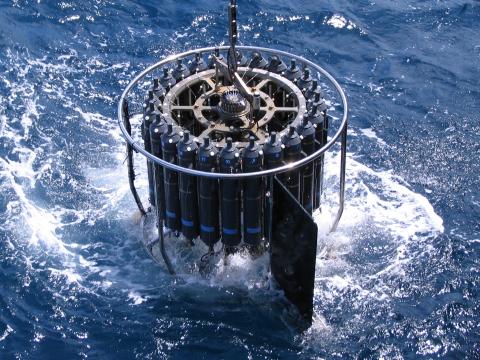
- There is a suggestion of earlier onset of seasonal stratification in UK shelf seas and tentative evidence of long-term trends in the strengthening of stratification.
- Stratification in coastal regions influenced by freshwater inputs shows no discernible long-term trends against the background of natural variability.
Low evidence, medium consensus
There is good agreement between the observation and modelling studies and good understanding of the basic controls of stratification caused by surface heating. However, long-term observational data is limited in scope and less is known about the roles of salinity and freshwater in coastal and shelf stratification. Models have less reliability in depicting salinity fields. There is a need for better long-term data on stratification, to capture the onset/breakdown, the strength, and the relative contributions of heating and salt/freshwater. Observations require both long-term sustained moored instrumentation and regular ship-based and autonomous vehicle sampling of key sites. Stratification caused by freshwater inputs (from estuaries and via rainfall) is particularly difficult to assess because of a lack of consistent long-term salinity observations.
- Projections suggest that by 2100, thermal stratification in UK shelf seas will extend in duration by around 2 weeks (with both earlier onset and later breakdown), and increase in strength, due to changes in air temperature.
- The timing of stratification may also respond to changes in winds (which can drive or prevent stratification) and rainfall.
- Future large-scale deployments of floating offshore wind turbines in deeper, seasonally stratifying waters have the potential to disrupt stratification.
- Projected changes to shelf-sea stratification may lead to less upward mixing of nutrients, possible reductions in primary productivity and changed in bottom water dissolved oxygen.
- More rainfall and run-off from the land could increase coastal stratification and exacerbate eutrophication.
Low evidence, low agreement
The UKCP09 predictions were the first attempt at regional-scale assessment of changes in the marine climate over the next century and were extended using a model ensemble by Tinker et al. (2016), and more recently Tinker et al. (2024). There is broad confidence of the ability of the model to predict changes over the open-shelf seas where surface heating/cooling is the dominant control. There are some uncertainties locally close to the shelf edge and in regions influenced by estuaries; more confidence is also required in how changes in salinity, both in the shelf interior and in the open ocean, will contribute to future stratification. The overall lack of confidence arises from (1) predictions of both the timing and strength of stratification are determined by changes in regional meteorology, which is a challenging aspect of future climate projections, and (2) stratification caused by salinity changes is much more difficult to model than that caused by surface heating/cooling.
- Increasing the range of observations, including temporally and spatially well-resolved temperature and salinity, and better data and understanding of deep-water oxygen concentrations.
- Model developments are now beginning to address the physics of the shelf edge and other small-scale processes. There remain modelling challenges in simulating salinity, riverine inputs, intermittent coastal stratification, and the role of stratification in controlling vertical mixing.
- Continuing research into emerging issues, including the role of rainfall in stratification, climate-driven changes in rainfall and wind patterns, marine heatwaves, and the impacts of large-scale deployment of offshore wind turbines in seasonally stratifying shelf seas.
Image credit: Jonathan Sharples